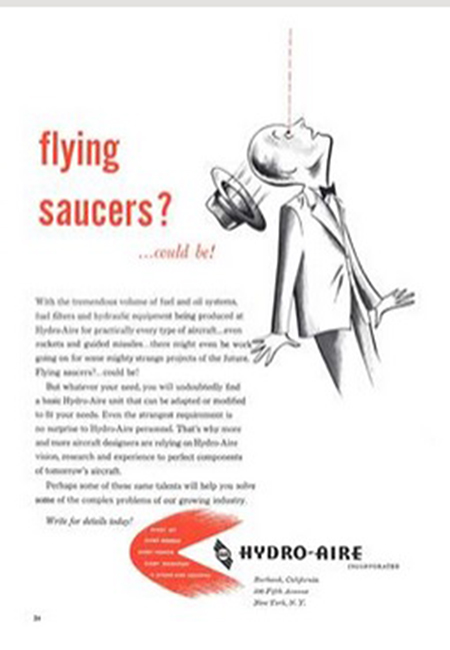|
One is constantly aware that we live in a world where dreams and reality interchange - Charles Lindbergh |
 |
Advertisement from AVIATION WEEK magazine - June 26, 1950
|
Objectives
The aim of this website is to examine the collision between Cold War technology and the UFO phenomenon.
"Flying saucers" appeared in 1947 at a time when the US military establishment, particularly the Air Force, was undergoing a revolutionary transformation. Its World War II-vintage propeller-driven aircraft were being replaced by jets that were capable of flying at the speed of sound. Breakthroughs in radar, electronics, rocketry, aerodynamics and the exploitation of nuclear energy were demolishing old strategic doctrines and raising frightening specters of even more terrible weapons to come. Since technological know-how equated to military advantage, a new breed of institutionalized secrecy was cloaking science and engineering in shrouds of mystery as one state attempted to shield its discoveries from another.
The decade 1947-1957, which is the main focus of this site, was characterized by a breakneck pace of military-driven aeronautical innovation that may never be duplicated, with wave after wave of new aircraft and weapons being superseded by even more advanced designs even before they had reached operational service. In October 1947, an airplane first exceeded the speed of sound. In October 1957, the first satellite was put in orbit, flying over twenty times faster. The feverish rate of progress had accelerated to a blur, and no end seemed to be in sight.
How did these trends interact with the US Air Force's study and understanding of Unidentified Flying Objects? How was the post-WWII military-technological boom linked to concepts about what UFOs might be?
This website consists of a number of interrelated articles that examine different facets of these questions. Some of these papers deal with projects for saucer-like aircraft, missiles or spacecraft, and are intended to provide some insight into the dreams and theories of engineers (like German rocket engineer Walter Riedel, NASA aerodynamicist Paul Hill and Lockheed "Skunk Works" chief Kelly Johnson) who may have been influenced by UFO reports. Other pages look at particular UFO cases in hopes of uncovering links to aerospace and intelligence projects and trends of thought.
ufx.org takes the position that there is a genuinely puzzling UFO phenomenon with a history long predating the rise of the Cold War, but is agnostic about what UFOs are. This website is an attempt to establish an alternative to the arguments of those who suspect that postwar advanced technology was somehow derived from captured extraterrestrial spacecraft, and the theories of those who insist with equal certainty that all UFO are actually supersecret vehicles created by shadowy military design bureaus. The site uses an assembly of documents to support the thesis that for many years the military and aircraft industry in the US were haunted by UFOs, unable to decide whether they represented exotic foreign developments or even, possibly, alien vehicles of some kind - that is, if they were real at all. It is an attempt to use verifiable documents to weave the study of UFOs more closely into "legitimate" postwar aerospace history. Hopefully it will encourage qualified historians to revise their attitudes toward the subject. Many of the heroes of aerospace history were involved with the "flying saucer" phenomenon in surprising ways, and not all of them were UFO skeptics - far from it.
The US military reaction to these reports (which should largely be seen as distinct from the scientific reaction to UFOs) in the late 1940s and early 1950s ranged well into murky areas of worst-case-scenarios, might-be's and contingency theories -- and even beyond that -- projecting elements of current American research projects onto fears of secret enemy breakthroughs. In many ways these anxieties paralleled the most lurid contemporary rumors and fears about Soviet Communism and the insidious Red Menace.
For me, the biggest surprise in these documents is the large number of reports of apparent missile sightings and impacts - or more properly, of suspected missile sightings and impacts - in many parts of the world, over a time span extending from 1945 through to at least the late 1950s. These incidents were lumped in with UFO reports by intelligence forces in many cases probably because there was no better category for them. There was not enough evidence to prove that missiles had been involved, but the suspicions remained, so the objects were called UFOs and the reports were stockpiled in hopes that a pattern would eventually emerge and a solution would appear. In aggregate, they give one the feeling that the Cold War consisted of an ongoing low-intensity rocket bombardment of the West by the USSR. Of course this could not have been the case, but it does raise questions as to how these kinds of reports may have contributed to the noise level of hostility and intrigue that placed the superpowers in a state of mutual suspicion and distrust. Did the Soviets collect the same types of reports about suspected Western missiles on their side too? Can these old reports, particularly the ones that gave rise to the 1946 Scandanavian cruise missile panic, help provide some long-term historical perspective on current controversies about suspected missile developments in emerging nuclear-capable nations? More to the point, just how much of a role did UFO reports play in the early formative period of the Cold War?
Obviously, many of the statements in these articles represent judgments and opinions, but these should be obvious for what they are. UFO history is an extremely complex and ambiguous field, and it is inevitable that readers will disagree with at least some of the ideas and theories presented here. Corrections, comments and additions of a factual or technical nature are welcome and appreciated.
At the time of the site's launch, only a few of the planned articles are available. ufx.org is constantly under revision and will evolve and grow. Check back occasionally to see new things.
contact >> imagery at ufx.org
August 2002